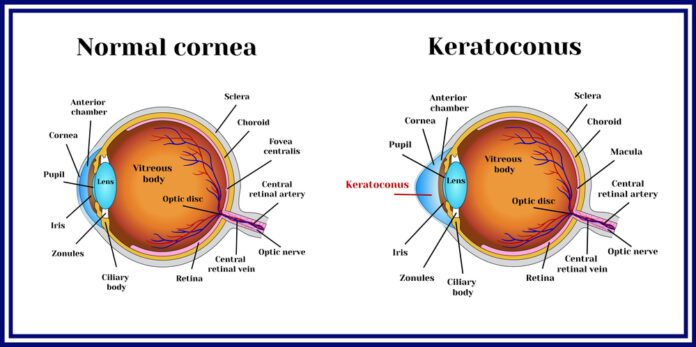Overview Of Keratoconus
Keratoconus is an eye condition that affects the shape of the cornea, which is the clear outer covering of the eye. In this condition, the cornea thins and bulges outward, eventually resembling a cone shape. These corneal abnormalities, which worsen over time, can lead to nearsightedness (myopia), blurred vision that cannot be improved with corrective lenses (irregular astigmatism), and vision loss.
Other corneal changes typical of this condition that can be seen during an eye exam include iron deposits in the cornea that form a yellow-to-brownish ring, called the Fleischer ring, surrounding the colored part of the eye (iris). Affected individuals may also develop Vogt’s striae, which are thin, vertical, white lines in the tissue at the back of the cornea.
Keratoconus may affect only one eye at first, but eventually, the corneas of both eyes become misshapen, although they might not be affected with the same severity. As the condition worsens, people with this condition can develop corneal scarring, often caused by exposure of the abnormally thin cornea to prolonged contact lens use or excessive eye rubbing.
The eye changes characteristic of keratoconus typically begin in adolescence and slowly worsen until mid-adulthood at which point the shape of the cornea remains stable.
Commonly Associated With
- bulging cornea
- conical cornea
- KC
Causes Of Keratoconus
The cause of keratoconus is unknown. Researchers have studied many different factors, both genetic and environmental, that are thought to influence the risk of developing keratoconus.
The environmental factors that may contribute to keratoconus include excessive eye rubbing and the tendency to develop allergic disorders (atopy).
Excessive and vigorous eye rubbing can cause trauma to the cornea and may lead to its thinning. However, it is unclear whether eye rubbing leads to keratoconus or if eye rubbing is a response to eye discomfort in the early stages of the condition. If eye rubbing is not involved in the development of keratoconus, it likely contributes to the worsening of the condition.
Approximately one-third of individuals with keratoconus have an allergic disorder, although it is unclear how allergic disorders are related to the development of keratoconus. Allergies might trigger eye rubbing, which can aggravate eye problems.
Changes in multiple genes have been associated with developing keratoconus. Many of these variants have been found only in small populations or single families. In most individuals with this condition, a combination of genetic and environmental factors is needed for the condition to develop. However, some affected individuals seem to have a largely environmental cause for the condition while others seem to have a largely genetic cause. Individuals with a relative who has keratoconus have an increased risk of developing the condition compared to people without a family history.
More than a dozen genes have been associated with keratoconus. These genes have varied functions. The most frequently associated genes play roles in eye development, the formation and structure of the cornea, the intricate lattice of proteins and other molecules that forms in the space between cells (extracellular matrix), an immune system response called inflammation, and the regulation of cell growth. It is thought that a disruption in one of these processes, in combination with an environmental trigger, may lead to the development of keratoconus.
Keratoconus can be a feature of genetic syndromes, such as Leber congenital amaurosis and arterial tortuosity syndrome. When it is part of a syndrome, keratoconus is caused by the same genetic mutation that causes the syndrome. Mutations in the genes that cause syndromes with keratoconus have not been found to cause keratoconus without other features.
Other
Keratoconus is estimated to affect 1 in 500 to 2,000 individuals worldwide. In most cases, keratoconus is not inherited and occurs in individuals with no family history of the disorder.
The condition can also occur in families. In some cases, keratoconus is inherited in an autosomal dominant pattern, which means one copy of the altered gene in each cell is sufficient to cause the disorder. An affected person often has one parent with the condition, although some people who have a gene variant never develop the condition, a situation known as reduced penetrance.
Keratoconus can also be inherited in an autosomal recessive pattern, which means variants occur in both copies of the gene in each cell. The parents of an individual with an autosomal recessive condition each carry one copy of the altered gene, but they typically do not show signs and symptoms of the condition.



